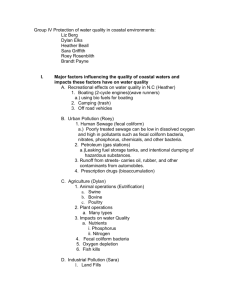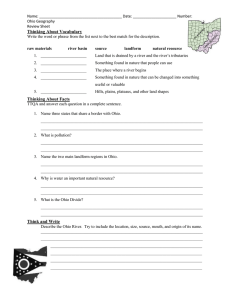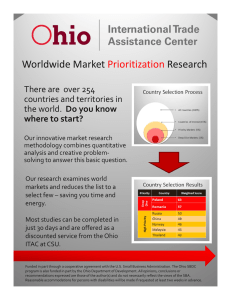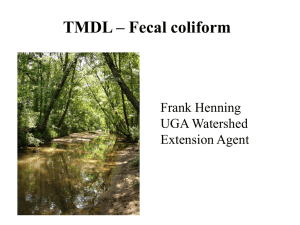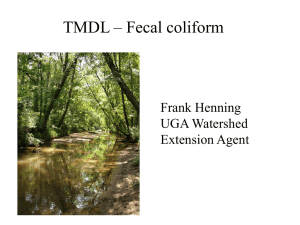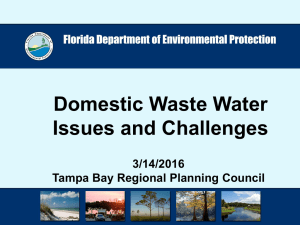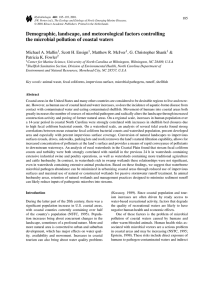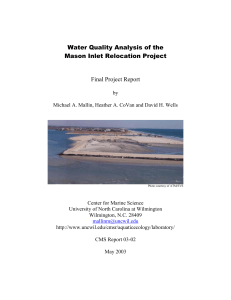The Comparison of Different Water Quality Characteristics along Yellow Creek,...
advertisement
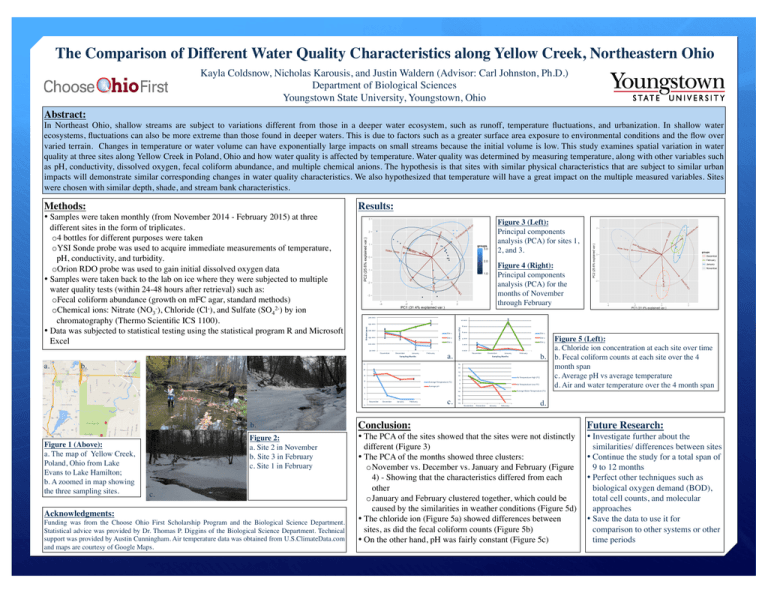
The Comparison of Different Water Quality Characteristics along Yellow Creek, Northeastern Ohio ! Kayla Coldsnow, Nicholas Karousis, and Justin Waldern (Advisor: Carl Johnston, Ph.D.)! Department of Biological Sciences! Youngstown State University, Youngstown, Ohio! Abstract:! In Northeast Ohio, shallow streams are subject to variations different from those in a deeper water ecosystem, such as runoff, temperature fluctuations, and urbanization. In shallow water ecosystems, fluctuations can also be more extreme than those found in deeper waters. This is due to factors such as a greater surface area exposure to environmental conditions and the flow over varied terrain. Changes in temperature or water volume can have exponentially large impacts on small streams because the initial volume is low. This study examines spatial variation in water quality at three sites along Yellow Creek in Poland, Ohio and how water quality is affected by temperature. Water quality was determined by measuring temperature, along with other variables such as pH, conductivity, dissolved oxygen, fecal coliform abundance, and multiple chemical anions. The hypothesis is that sites with similar physical characteristics that are subject to similar urban impacts will demonstrate similar corresponding changes in water quality characteristics. We also hypothesized that temperature will have a great impact on the multiple measured variables. Sites were chosen with similar depth, shade, and stream bank characteristics.! Results:! • Samples were taken monthly (from November 2014 - February 2015) at three different sites in the form of triplicates. ! o 4 bottles for different purposes were taken! o YSI Sonde probe was used to acquire immediate measurements of temperature, pH, conductivity, and turbidity. ! o Orion RDO probe was used to gain initial dissolved oxygen data ! • Samples were taken back to the lab on ice where they were subjected to multiple water quality tests (within 24-48 hours after retrieval) such as: ! o Fecal coliform abundance (growth on mFC agar, standard methods)! o Chemical ions: Nitrate (NO3-), Chloride (Cl-), and Sulfate (SO42-) by ion chromatography (Thermo Scientific ICS 1100).! • Data was subjected to statistical testing using the statistical program R and Microsoft Excel! Figure 3 (Left): ! Principal components analysis (PCA) for sites 1, 2, and 3.! ! Figure 4 (Right): Principal components analysis (PCA) for the months of November through February! 300.000$ 10.000$ Chloride)(ppm)) 250.000$ 200.000$ Site$1$ 150.000$ Site$2$ Coliform)(CfU)) Methods:! Site$3$ 100.000$ 8.000$ 6.000$ Site$1$ 4.000$ Site$2$ 50.000$ 0.000$ November$ December$ January$ February$ Sampling)Months) a. ! b. 15$ Average$Temperature$(°C)$ 4$ Average$pH$ Air$Temperature$High$(°C)$ 5$ 0$ Air$Temperature$Low$(°C)$ =5$ Average$Water$Temperature$(°C)$ =10$ =15$ 0$ November$ December$ January$ February$ =2$ c. February$ Sampling)Months) 10$ 6$ 2$ Figure 1 (Above): ! a. The map of Yellow Creek, Poland, Ohio from Lake Evans to Lake Hamilton; ! b. A zoomed in map showing the three sampling sites.! January$ 25$ 8$ ! December$ 20$ 10$ a. November$ a.! 12$ ! Figure 5 (Left): ! a. Chloride ion concentration at each site over time! b.! b. Fecal coliform counts at each site over the 4 month span! c. Average pH vs average temperature! d. Air and water temperature over the 4 month span! Site$3$ 2.000$ ! c.! =20$ =25$ November$ December$ January$ February$ d.! b. Conclusion:! Figure 2: ! a. Site 2 in November! b. Site 3 in February! c. Site 1 in February ! • The PCA of the sites showed that the sites were not distinctly • Investigate further about the different (Figure 3)! similarities/ differences between sites ! • The PCA of the months showed three clusters:! • Continue the study for a total span of o November vs. December vs. January and February (Figure 9 to 12 months ! 4) - Showing that the characteristics differed from each • Perfect other techniques such as other! biological oxygen demand (BOD), o January and February clustered together, which could be total cell counts, and molecular caused by the similarities in weather conditions (Figure 5d) ! approaches ! • The chloride ion (Figure 5a) showed differences between • Save the data to use it for sites, as did the fecal coliform counts (Figure 5b)! comparison to other systems or other • On the other hand, pH was fairly constant (Figure 5c)! time periods! ! ! Acknowledgments:! Funding was from the Choose Ohio First Scholarship Program and the Biological Science Department. Statistical advice was provided by Dr. Thomas P. Diggins of the Biological Science Department. Technical support was provided by Austin Cunningham. Air temperature data was obtained from U.S.ClimateData.com and maps are courtesy of Google Maps.! ! Future Research:!
